Watch this video to avoid common mistakes of life drawing
Enroll in the Life Drawing Academy now!
Why Life Drawing Classes do it wrong
By Vladimir London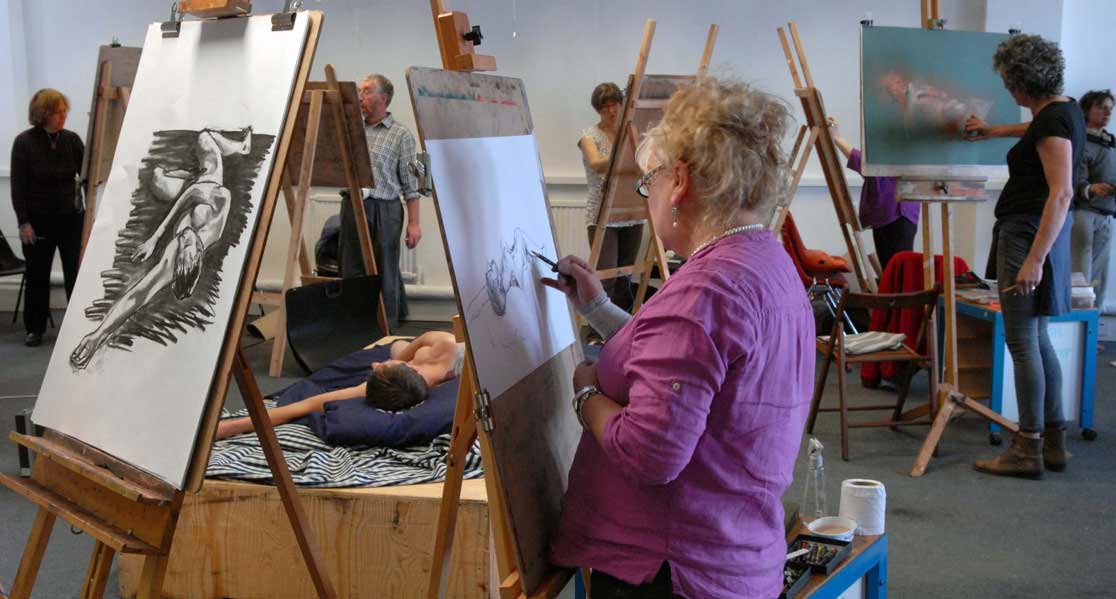
As a Drawing Academy tutor, I receive artworks for critique and questions from art students. Recently, one student, Louise asked me how to learn figure drawing. Here's what she wrote.
"I am attending life drawing sessions locally three days a week. These classes supposed to be educational, but I struggle every time the model takes a new pose. I cannot complete any drawing to my liking. I asked the teacher and he said that I have to loosen up my style. Every time I ask how to improve my sketch, the teacher says it is good; I just need to let my creativity flow. I'm not happy with my drawings and even less with the feedback. How can I loosen up and be creative if I don't even have the time to make a half-done drawing? Do you have any advice on how to get the most out of these life drawing sessions? Here are some of my drawings from life."
In this video, I will give a constructive critique on Louise's sketches and some tips on how to study life drawing.
First of all, it is great that Louise wants to learn figurative art by drawing from life. This is the right way to do. What is really sad is that she doesn't get any professional tutoring because her instructor is not fit for the job. Even worse, the life drawing classes do it wrong because she won't get good drawing skills even if she attends those life drawing sessions for years. I will explain why later on.
Let's begin with the artworks critique.
Looking at Louse's sketches, I can tell that she has some knowledge of human anatomy and body proportions, and it is great that she is trying to apply that knowledge in her works.
At the same time, there are many misjudgments of proportions and places with doubtful anatomy. For example, the classical proportions of contrapposto are completely off. The distance from the pit of the neck to the pubic bone should be equal to the distance from the top of the pelvis to the top of the knee cap and from that point to the toes. I understand that the model might have some deviations from the classical canons, but not that much. Also, one leg is clearly longer than another, which can be said about the arms as well. The head is not connected to the shoulders correctly because the first pair of ribs is misplaced. The hands are too small. They should be about as big as the height of the face. Also, the feet are too small. A foot should be a bit longer than a head, but it is not the case here. The elbow should be at the level where the ribcage ends; but it is higher in this drawing. The upper-arm, forearm and hand should be in the golden ratio to each other. This proportion is broken. There are many more wrong proportions here; but it would be too long to list them all. I just want to say that there is a room for improvement when it comes to drawing proportionate figures.
Now, about anatomy.
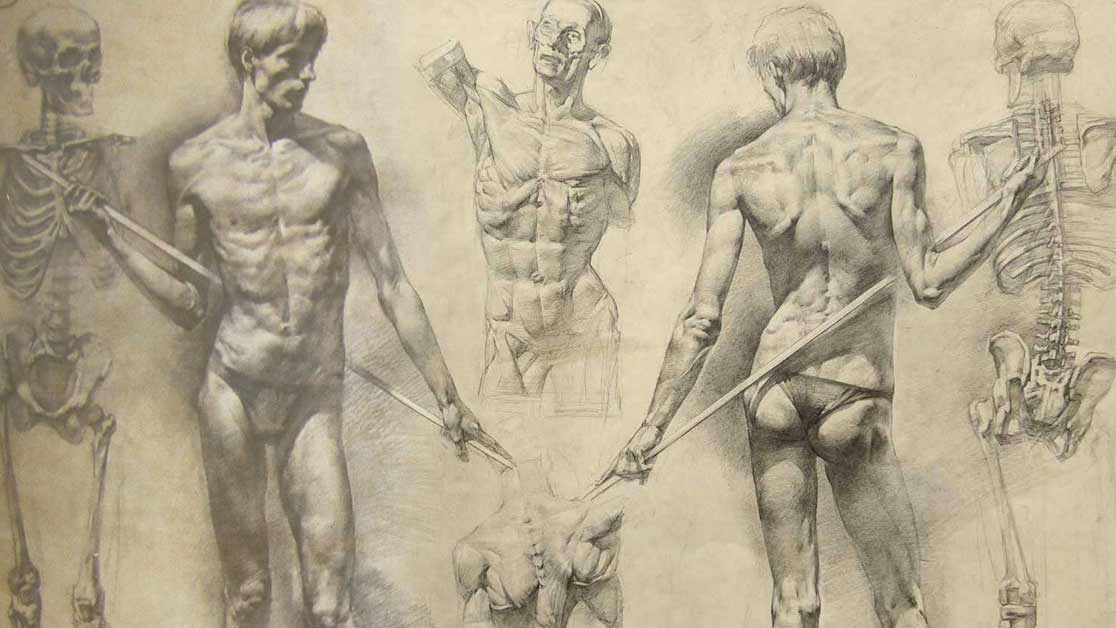
It is very good that Louise takes care of bones and muscles. At the same time, there are many places where anatomy can be improved. For example, the sternocleidomastoid muscle inserts to the base of the skull behind the ear, not in front of it. The muscles of the forearm in pronation have different geometry to the muscles in supination. Here, the difference between pronation and supination is not defined. The insertion of the deltoid should be at the middle of the upper arm. It is too short in this drawing. The pectoralis major, or the chest muscle, should have a different shape, according to the places of its origin and insertion. There are many other anatomy mistakes.
What I see in Louise's sketches is that anatomy and proportions is not her main challenge. She is missing basic, yet fundamental skills of drawing. To begin with, she has troubles with handling a pencil. Many outlines are done as series of very short strokes instead of confident lines. This tells me that she never had good art teachers who could help to "set up" her hand. She holds a pencil the wrong way. Such short strokes can only be done with the "writing grip, not the "candle grip". When drawing from life on a big scale, an artist should stand at an arm length from the vertically positioned easel. The "writing grip" forces an artist to stand or sit closer to an easel, which prevents seeing the whole artwork and noticing mistakes.
The biggest improvement Louise can make is to learn constructive drawing. She has difficulties with the linear and aerial perspective. The aerial perspective is totally absent here, while the linear perspective is reversed. These lines are not converging, but diverging. This is a very junior mistake.
Apart of constructive drawing, Louise also needs to work on her style of tonal rendering. The main purpose of tonal rendering is to reveal objects' three-dimensional construction. This is not the case in her drawings.
This brings us to the comment by her teacher about "loosen up" a style. You cannot "loosen up" what you don't have. And "going creative" is a pointless advice, because it won't help to improve drawing skills.
Now, about the life-drawing classes.
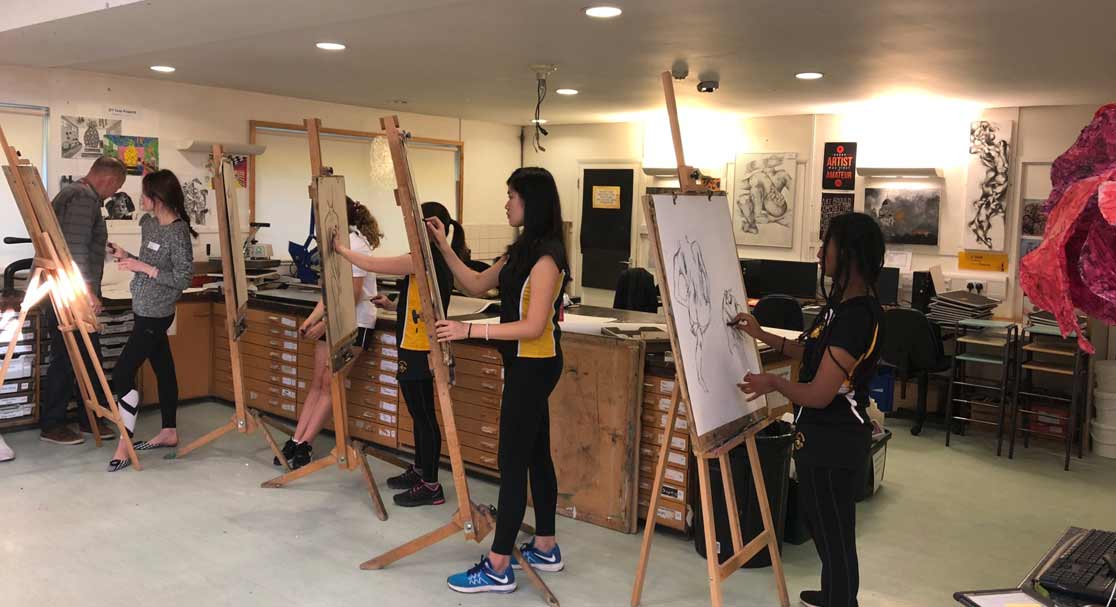
Judging by fast sketches and the comment that it is not enough time to complete one, I guess that the life drawing sessions Louise attends make one common mistake. This mistake prevents students from learning good drawing skills. It is having very short time for every pose.
I have been to many different life drawing classes in various cities and countries. In most cases, each session goes as follows. It begins with a series of very short 2- and 5-minute sketches, then a couple of 10- or 15-minute poses and after a break the session completes with what they call a "long pose" for 20 or so minutes. Each pose is very difficult, sometimes with great foreshortening and some yoga-style stance. Usually, a model, not a teacher decides on the pose.
Such setup is great if you already have strong figure drawing skills and would like to take a challenge of difficult poses under time pressure. However, if you are still learning how to draw figures and portraits, such fast sketching won't give you what you need. I know students who attend similar sessions for years with no progress whatsoever. This happens not because students do something wrong, but because life drawing classes are not setup properly.
By classical education standards, 20-minute is a very short sketch. Real education starts when you draw twenty- to forty-hour poses. Needless to say, that an art teacher has to first give the necessary knowledge. Depicting a human body requires a great deal of understanding and practice of constructive drawing principles, perspective, anatomy, and proportions. Should you have some gaps in those skills, all will come out as mistakes.
In classical curriculum, students do not start learning those principles on live models; instead, they spend years on drawing still-lives, draperies, muscle écorché, skeletons and skulls, classical sculptures, and busts before moving to drawing live people.
Here's the ideal scenario of getting ready for life drawing: After learning constructive drawing principles, anatomy and proportions, a student would need to spend a good deal of time drawing long poses: 4 to 20 hours per artwork. Speed is not important at that time. A student needs to develop the necessary skills of drawing human figures and portraits in the right sequence of steps. When the foundation is in place, then fast sketching will be the next step forward. Sped is a sub-product of mastery, not vice versa.
I really advocate drawing from life at every opportunity and attending a life-drawing class will be great thing to do. Even if your life drawing class does it wrong, you can still benefit from such life sessions.
Now, I will give you some helpful tips.
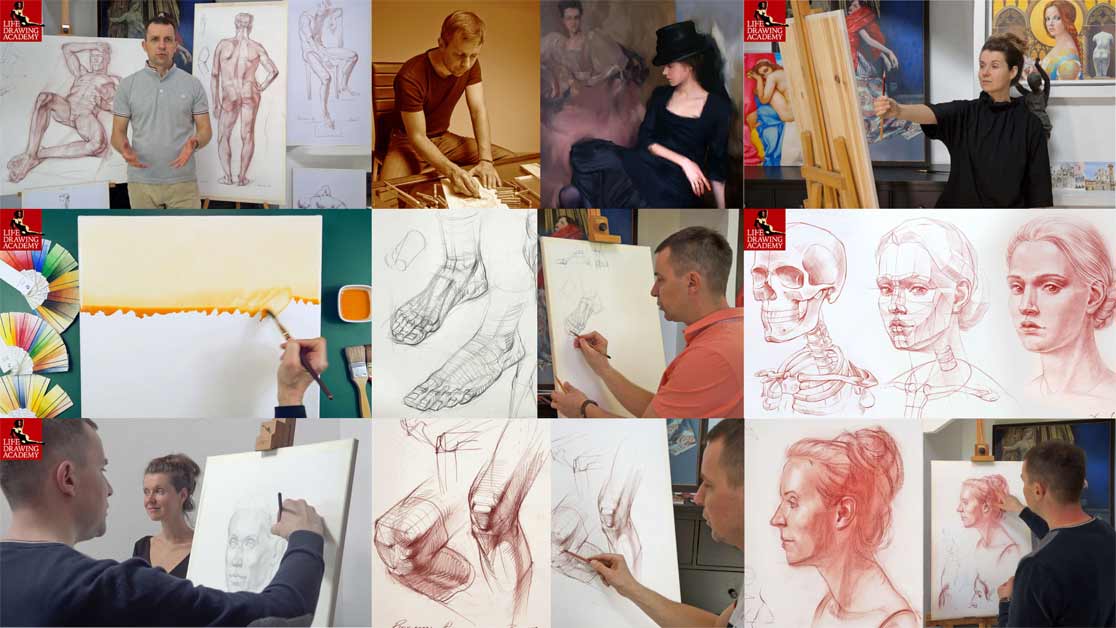
Draw with graphite pencils. Creative smearing of dusty pigment of charcoal or sanguine on paper won't give you good skills of drawing with precision.
When your class practice very short poses, draw slowly small-scale figures. Also, you may work on smaller tasks – drawing a hand, nose, ear, etc.
If time permits, draw full figures. Do not attempt tonal rendering until the solid construction with correct anatomy and proportions is in place. Rendering values of a badly done drawing is like painting a shaky house in a hope that lick of paint will fix it.
And here's the main tip - draw what you know, not what you see. Above all, it means that you have to apply the knowledge if anatomy and construction in your drawings. These things are hidden beneath the skin and you can't do it from observation.
Coming back to this drawing, should you know that the sternocleidomastoid muscle inserts behind the ear, you won't make a junior mistake of misplacing it. This is drawing what you know means.
Needless to say, the necessary knowledge has to gained first. This is where we can help you. We created the Life Drawing Academy courses for students like you. Now you can study how to draw realistic portraits and figures from life, memory and imagination in the fast and easy way.
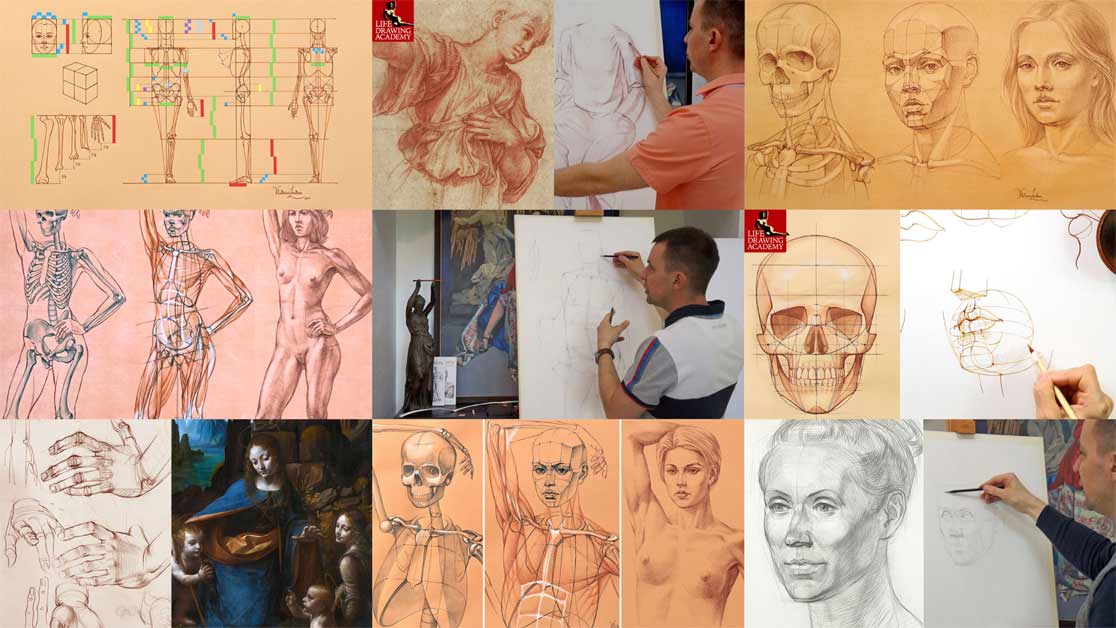
There are two courses at this academy – the Online Course, a self-study course where you can learn figurative drawing by watching 52 video lessons, and the Correspondence Course, where you will get unlimited personal tutoring from the talented fine artists and professional art teachers. The personal tutoring course is suitable for both complete beginners and advanced artists because you will get a drawing curriculum designed for your level of skills. In this course, in addition to video lessons, you will get 100 drawing tasks that will be explained and demonstrated in depth. There is no way to fail because the academy tutors will walk you all the way step by step until you achieve an advanced level of drawing skills.
This personal tutoring is unique. It will cover all drawing topics that you need to know – how to hold and use a pencil, how to draw in perspective, how to use constrictive drawing principles, golden proportions, anatomy, rules of composition, and so on. No art college would ever give you such custom-designed curriculum and unlimited tutoring for a one-time low fee.
To learn good drawing techniques, enroll in the Life Drawing Academy course:
Online Course
A self-study, self-paced course for you to learn fundamental methods of classical drawing and improve life drawing skills by watching video lessons and doing assignments
- Unlimited access to 52 life drawing video lessons
- Lifetime membership without deadlines
- Unlimited support from the Academy tutors
- Constructive critique of your artworks
- Member access to the Academy's Art community
- Place in the Academy's Students Gallery
- Exclusive members-only newsletter and bonuses
- Life Drawing Academy Diploma of Excellence in your name
One-time payment - Lifetime membership
$297 USD
Personal Tutoring Online + Online Course
The ultimate choice if you who would like to receive personal, one-to-one tutoring from the Academy teachers, which is custom-tailored to your skills and needs
- Everything in Online Course, plus:
- Dedicated team of art tutors
- Assessment of your current level of drawing skills
- Personalized curriculum tailored to your skills and goals
- Up to 100 drawing tasks with by-task assessment
- Unlimited one-to-one personal coaching with detailed per-task instructions and feedback
- Artwork critiques and results-oriented guidance
One-time payment - Lifetime membership
$997 USD




